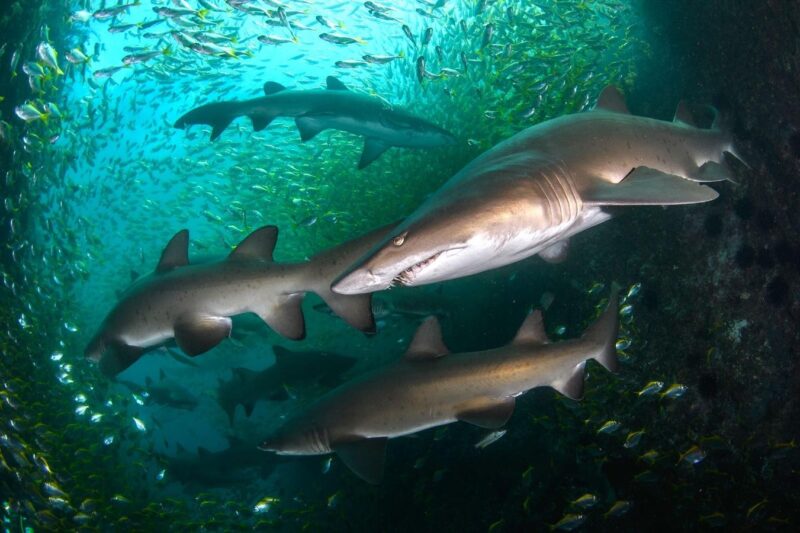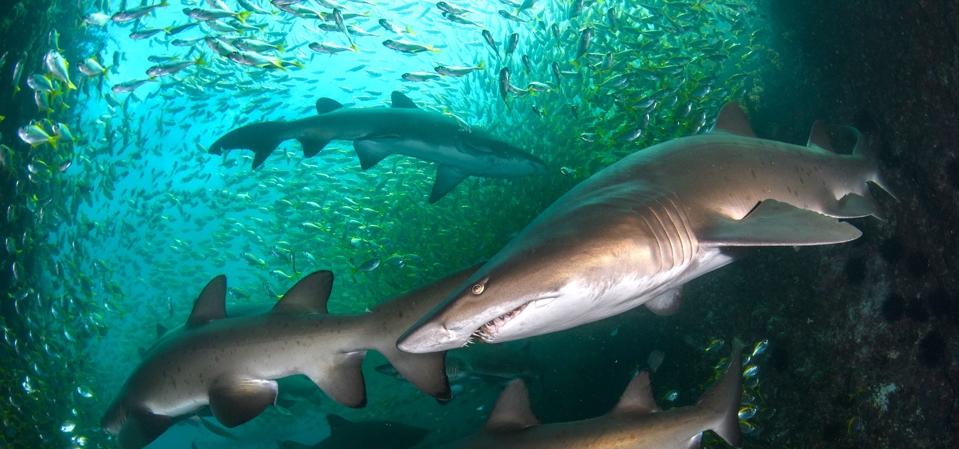Dive beneath the surface with 2025’s best ocean photography, and get a glimpse into the hidden lives of sharks, whales and sea dragons.
© Nicolas & Léna REMY
Since 1995, the annual Nature’s Best Photography Awards strive to bring together some of the finest nature photographers in the world. This year has been no different; we’ve been lucky enough to see some of the most remarkable and elusive moments in the natural world, across different continents and ecosystems.
For us land-dwellers, the ocean remains one of the planet’s last great mysteries. It covers more than 70% of Earth’s surface, yet it remains largely unexplored. It’s home to species and ecosystems that many of us will never see in person. The underwater category of this year’s competition highlights precisely that: silent hunters, vibrant reefs and intimate encounters between creatures that live far beyond our reach.
Here are nine of the best.
1. Sand Tiger Sharks (Fish Rock Island, New South Wales) — Category Winner
Sand tiger sharks
By © Nicolas Remy of Sydney, NSW, Australia
This year’s Ocean Views category winner, captured by photographer Nicolas Remy, is nothing short of mesmerizing. We see a school of sand tiger sharks, gliding through clouds of fish off Fish Rock Island, New South Wales.
The image captures the strange grace and coexistence of a species often misunderstood. “Fish Rock Island was named one of the world’s ‘Hope Spots’ to help protect marine habitat,” explains Remy. “Photography opens a window into this hidden world, allowing us to share its beauty and fragility.”
The sand tiger shark (Carcharias taurus), known in Australia as the grey nurse shark, cuts an intimidating figure with its jagged teeth and robust build. Yet, despite its fearsome appearance, it is a relatively slow-moving and non-aggressive species. Sand tigers are masters of buoyancy control, gulping air into their stomachs to hover motionless in the water column.
Tragically, as research from Aquatic Conservation: Marine and Freshwater Ecosystems explains, overfishing and habitat degradation have earned this species a Critically Endangered status on the IUCN Red List. Remy’s shot is a last call to protect the last refuges of these gentle giants.
2. Humpback Whale Calf (Vava’u, Kingdom of Tonga)
Humpback whale calf
By © Charlie Wemyss-Dunn of Boston, Massachusetts, USA
In the shallows of Tonga’s Vava’u archipelago, a humpback whale calf plunges vertically in the water, post-dive, with its nose pointing down toward the deep. The image captures a calm moment in the life of a young leviathan, who will one day have to migrate thousands of kilometers across the Pacific.
Humpback whales (Megaptera novaeangliae) are known for their brilliant acrobatics and songs. Males use their songs, in particular, to attract mates and communicate across vast distances. Calves typically stay close to their mothers for up to a year; they feed on their mothers’ nutrient-rich milk, while learning the routes that will eventually define their lives as adults.
3. Sally Lightfoot Crab (Galápagos Islands, Ecuador)
Sally lightfoot crab
By © Kevin Lohman of Santa Cruz, California, USA
Vibrant, alert and seemingly unbothered by the camera, a Sally Lightfoot crab (Grapsus grapsus) stares straight down the lens. With scarlet legs, a cornflower-blue underbelly and glinting purple eyes, it’s hard to believe this specimen isn’t painted. These crabs are so vividly colored that they border on the surreal.
Native to the rocky shores of the Galápagos and other Pacific coasts, these crabs play a crucial ecological role as scavengers, feeding on algae and detritus (dry bird excrement) that would otherwise accumulate along the shorelines. Researchers have long marveled at their agility, noting that their grip and speed help them eat, as well as evade predators — including curious photographers.
4. Titan Triggerfish (Mayotte Island, France)
Titan triggerfish
By © Gabriel Barathieu of Mayotte Island, France
Few fish are as bold as the titan triggerfish (Balistoides viridescens). This curious specimen was captured face-to-face with the photographer in the waters off Mayotte Island. Its powerful jaw, sharp teeth and determined gaze make for a great portrait of underwater confidence.
The titan is, as its name suggests, one of the largest species in the triggerfish family. This species in particular is known for its territorial behavior, especially during nesting season. Divers often report being chased or confronted if they get even a little too close to their nesting site. Despite their reputation, however, they’re essential to reef ecosystems.
5. Sleeping Sperm Whales (Dominica)
Sperm whales asleep
By © Reiko Takahashi of Kitakami, Iwate, Japan
In what’s arguably one of the most intimate scenes ever captured in the deep, two sperm whales (Physeter macrocephalus) rest side by side. One gently leans its head on the other’s back as, behind, a third drifts along with them. What you might not realize from this image’s staging, however, is that sperm whales sleep vertically.
These whales are the largest toothed predators on Earth. They dive more than a kilometer deep in search of squid. They’re so elusive that, for years, scientists believed they never truly slept. Eventually, researchers realized that sperm whales prefer short, synchronized naps while floating upright. Most fascinatingly, they only sleep with one half of their brain at a time.
6. Leafy Sea Dragon (Rapid Bay, South Australia)
Leafy seadragon
By © Nicolas Remy of Sydney, NSW, Australia
The leafy sea dragon (Phycodurus eques) looks like something out of an alien world. Here, we see it drifting through dark waters, with its ornate “leaves” glowing in shades of orange and gold. They’re found exclusively along the southern and western coasts of Australia.
As you might’ve been able to guess, this species is a master of camouflage. The “leaves” you see aren’t appendages used for movement, but rather for disguise. With them, they blend almost perfectly with seaweed and kelp. Much like their close relatives, seahorses, leafy sea dragons share a similar reproductive quirk: males carry and nurture the eggs until they hatch Sadly, habitat loss and pollution currently pose large threats to its survival.
7. Brandt’s Cormorant in School of Sergeant Major Fish (Sea of Cortez, Mexico)
Brandt cormorant inside school of fish
By © Oscar Díez of Madrid, Spain
This lone Brandt’s cormorant (Urile penicillatus) looks out of place in the middle of a school of sergeant major fish. As calm as the shimmering scene looks, this photo captures a primal moment between predator and prey.
Brandt’s cormorants are adept divers, as research from The Journal of Experimental Biology illustrates. They’re capable of reaching depths of over 30 meters (98 ft) in pursuit of fish. You can find them along the Pacific coast from Alaska to Baja California, where they rely on healthy fish populations and clear waters for survival.
8. Larval Tripod Fish (Palm Beach, Florida)
Larval tripod fish
By © Steven Kovacs of Palm Beach, Florida, USA
Delicate and ethereal, a larval tripod fish (Bathypterois grallator) floats in the blackness of the deep sea. Its translucent fin edges are streaked with a palette of orange, blue and violet. At this stage in this species’ development, it looks almost alien: a luminous wisp in a world without sunlight.
The adult tripod fish, however, is even more odd. Adult fin rays are elongated in order for them to “stand” on the ocean floor, while waiting for drifting prey. Capturing one at the larval stage is exceptionally rare; these juveniles inhabit the midwater zones, which is far beyond the reach of most divers.
9. Goby on Tridacna Clam (Raja Ampat, Indonesia)
Goby on tridacna clam
By © Wayne Lai of Hong Kong
Tiny but captivating, a goby (Gobiodon sp.) peers out from the rippled folds of a giant tridacna clam. The clam’s iridescent mantle shimmers with electric blues and greens, which has seemingly created the perfect protective and camouflaging fortress — for the inch-long fish is nestled within.
Gobies and tridacna clams share a mutually beneficial relationship: the fish gain shelter from predators, while their movements help keep the clam’s surface clean. This symbiosis is just one of countless tiny alliances that make coral reefs among the most complex ecosystems on Earth.
Are fish the least of your worries when it comes to the ocean? Take the science-backed Thalassophobia Test to find out how deep your fear of the ocean runs.








